Emirates Airlines Company and Industry Overview
VerifiedAdded on 2023/06/14
|11
|3593
|85
AI Summary
This article provides an overview of Emirates Airlines Company and Industry. It includes the company profile, vision, mission, goals, and business strategy. It also discusses the Porter Analysis of Emirates Airlines, including the threat of new entrants, bargaining power of buyers and suppliers, threat of substitutes, and industry rivalry.
Contribute Materials
Your contribution can guide someone’s learning journey. Share your
documents today.
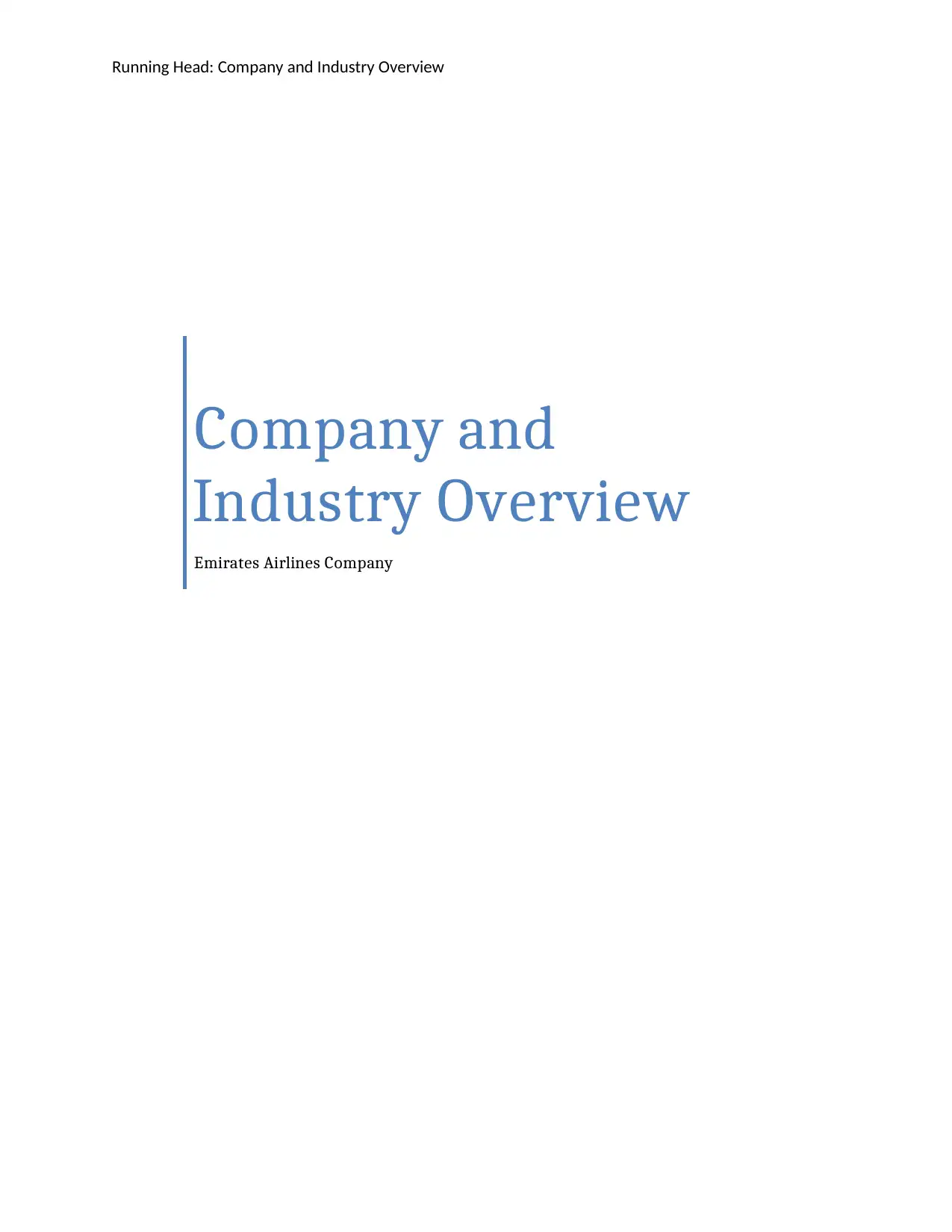
Running Head: Company and Industry Overview
Company and
Industry Overview
Emirates Airlines Company
Company and
Industry Overview
Emirates Airlines Company
Secure Best Marks with AI Grader
Need help grading? Try our AI Grader for instant feedback on your assignments.
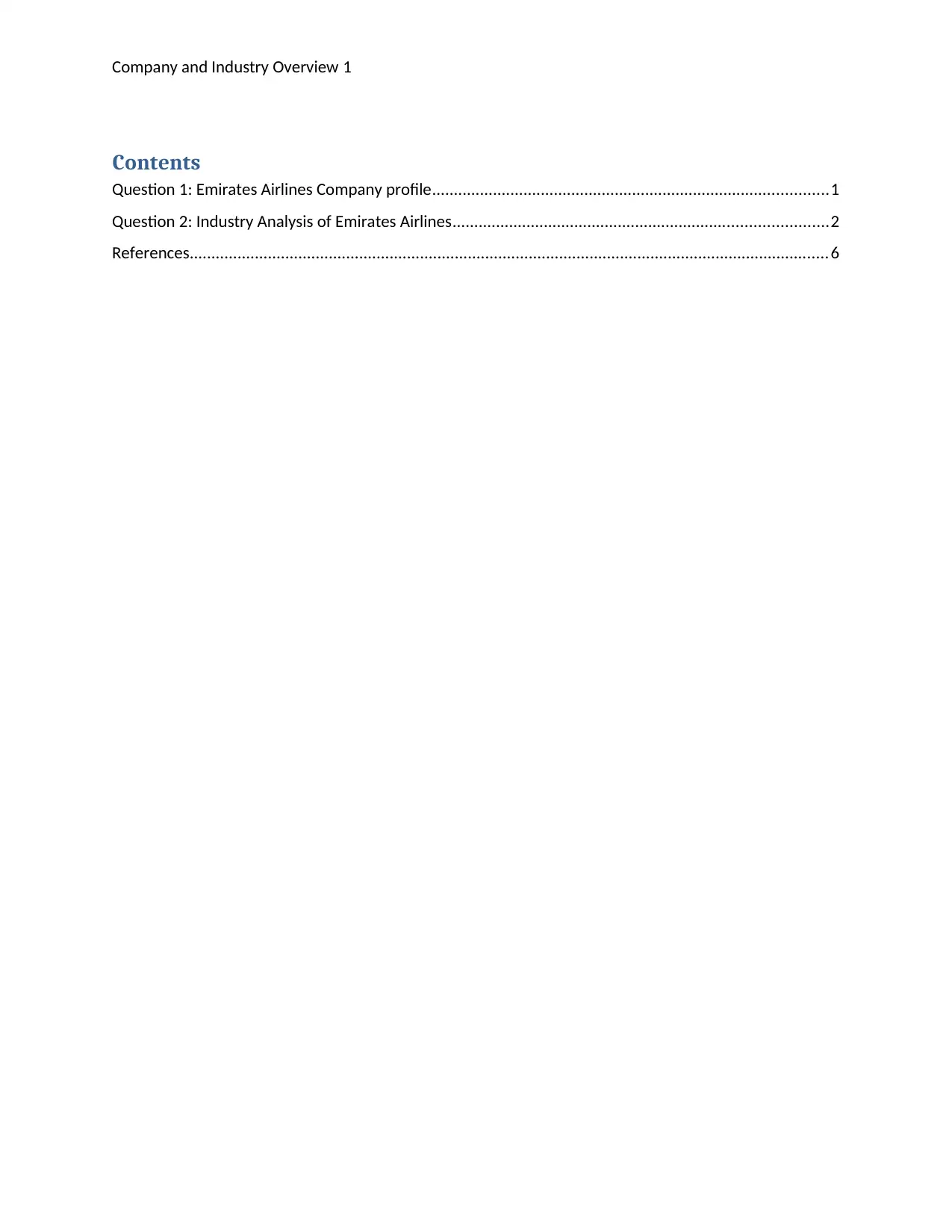
Company and Industry Overview 1
Contents
Question 1: Emirates Airlines Company profile...........................................................................................1
Question 2: Industry Analysis of Emirates Airlines......................................................................................2
References...................................................................................................................................................6
Contents
Question 1: Emirates Airlines Company profile...........................................................................................1
Question 2: Industry Analysis of Emirates Airlines......................................................................................2
References...................................................................................................................................................6

Company and Industry Overview 2
Question 1: Emirates Airlines Company profile
Emirates is an airlines based in Dubai, United Arab Emirates. The airlines are a subsidiary of
The Emirates Group that is a wholly owned government company. The company is the last
organization in the Middle East working with 3600 flights every week from its hub of Dubai
International Airport. The company is involved in more than 140 cities in total 81 countries and
six continents as well. Further, the cargo activities are done by Emirates SkyCargo (Emirates
UAE, 2018). The company was founded in the year 1985 and is now renowned as the fourth
largest airline company in the world in terms of international passengers carried and the second
largest in terms of freight tonne kilometers flown. The company has the longest commercial
flight running from Dubai to Auckland. In the current era, the company flies world biggest fleet
of Airbus A380s and Boeing 777s, and it provides a greater degree of satisfaction level to the
customers by providing comfort services (Farouk, Cherian, & Shaaban, 2017).
The company was established in October 1985 in Dubai, United Arab Emirates. Emirates in now
known as world largest airlines that provides fastest growing carrier services worldwide. The
company is known for its luxury class services provided to its customers worldwide. The
company i also growing its network aggressively so as to provide their efficient services to
maximum customers worldwide. The airlines operate with a fleet of widebody equipment and as
discussed above it is the largest operator of Airbus A380 aircraft type. The company maintains
their hub at the Dubai International Airport; the airport provides an extension network of services
in different areas like Middle East along with Asia, North America, Africa, South Pacific,
Europe and lastly South America. The SkyCargo airfreight division of Emirates currently serves
around 40 destinations (Beik, & Galbraith, 2016).
Vision mission goals business strategy
Further, the vision of the company is to become the leader in the aviation industry. They aim to
initiate their activities innovatively that keeps environment as their first priority. Apart from that,
the company aims to make a global coverage through their activities. They want to reach in
every country and provide services to people. The vision statement of Emirates also includes that
follows strict compliance to keep the customers feel safe while travelling. They have employed a
Question 1: Emirates Airlines Company profile
Emirates is an airlines based in Dubai, United Arab Emirates. The airlines are a subsidiary of
The Emirates Group that is a wholly owned government company. The company is the last
organization in the Middle East working with 3600 flights every week from its hub of Dubai
International Airport. The company is involved in more than 140 cities in total 81 countries and
six continents as well. Further, the cargo activities are done by Emirates SkyCargo (Emirates
UAE, 2018). The company was founded in the year 1985 and is now renowned as the fourth
largest airline company in the world in terms of international passengers carried and the second
largest in terms of freight tonne kilometers flown. The company has the longest commercial
flight running from Dubai to Auckland. In the current era, the company flies world biggest fleet
of Airbus A380s and Boeing 777s, and it provides a greater degree of satisfaction level to the
customers by providing comfort services (Farouk, Cherian, & Shaaban, 2017).
The company was established in October 1985 in Dubai, United Arab Emirates. Emirates in now
known as world largest airlines that provides fastest growing carrier services worldwide. The
company is known for its luxury class services provided to its customers worldwide. The
company i also growing its network aggressively so as to provide their efficient services to
maximum customers worldwide. The airlines operate with a fleet of widebody equipment and as
discussed above it is the largest operator of Airbus A380 aircraft type. The company maintains
their hub at the Dubai International Airport; the airport provides an extension network of services
in different areas like Middle East along with Asia, North America, Africa, South Pacific,
Europe and lastly South America. The SkyCargo airfreight division of Emirates currently serves
around 40 destinations (Beik, & Galbraith, 2016).
Vision mission goals business strategy
Further, the vision of the company is to become the leader in the aviation industry. They aim to
initiate their activities innovatively that keeps environment as their first priority. Apart from that,
the company aims to make a global coverage through their activities. They want to reach in
every country and provide services to people. The vision statement of Emirates also includes that
follows strict compliance to keep the customers feel safe while travelling. They have employed a
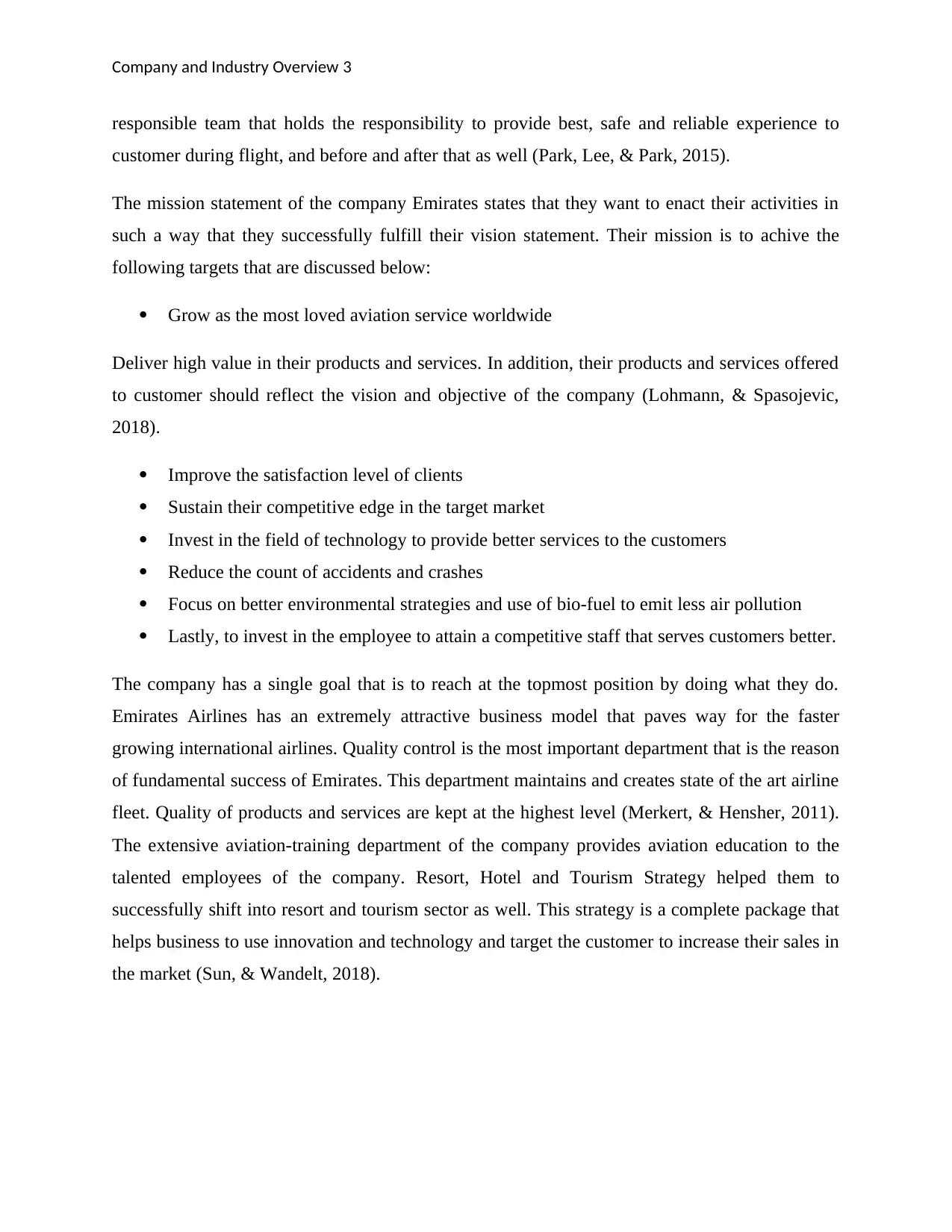
Company and Industry Overview 3
responsible team that holds the responsibility to provide best, safe and reliable experience to
customer during flight, and before and after that as well (Park, Lee, & Park, 2015).
The mission statement of the company Emirates states that they want to enact their activities in
such a way that they successfully fulfill their vision statement. Their mission is to achive the
following targets that are discussed below:
Grow as the most loved aviation service worldwide
Deliver high value in their products and services. In addition, their products and services offered
to customer should reflect the vision and objective of the company (Lohmann, & Spasojevic,
2018).
Improve the satisfaction level of clients
Sustain their competitive edge in the target market
Invest in the field of technology to provide better services to the customers
Reduce the count of accidents and crashes
Focus on better environmental strategies and use of bio-fuel to emit less air pollution
Lastly, to invest in the employee to attain a competitive staff that serves customers better.
The company has a single goal that is to reach at the topmost position by doing what they do.
Emirates Airlines has an extremely attractive business model that paves way for the faster
growing international airlines. Quality control is the most important department that is the reason
of fundamental success of Emirates. This department maintains and creates state of the art airline
fleet. Quality of products and services are kept at the highest level (Merkert, & Hensher, 2011).
The extensive aviation-training department of the company provides aviation education to the
talented employees of the company. Resort, Hotel and Tourism Strategy helped them to
successfully shift into resort and tourism sector as well. This strategy is a complete package that
helps business to use innovation and technology and target the customer to increase their sales in
the market (Sun, & Wandelt, 2018).
responsible team that holds the responsibility to provide best, safe and reliable experience to
customer during flight, and before and after that as well (Park, Lee, & Park, 2015).
The mission statement of the company Emirates states that they want to enact their activities in
such a way that they successfully fulfill their vision statement. Their mission is to achive the
following targets that are discussed below:
Grow as the most loved aviation service worldwide
Deliver high value in their products and services. In addition, their products and services offered
to customer should reflect the vision and objective of the company (Lohmann, & Spasojevic,
2018).
Improve the satisfaction level of clients
Sustain their competitive edge in the target market
Invest in the field of technology to provide better services to the customers
Reduce the count of accidents and crashes
Focus on better environmental strategies and use of bio-fuel to emit less air pollution
Lastly, to invest in the employee to attain a competitive staff that serves customers better.
The company has a single goal that is to reach at the topmost position by doing what they do.
Emirates Airlines has an extremely attractive business model that paves way for the faster
growing international airlines. Quality control is the most important department that is the reason
of fundamental success of Emirates. This department maintains and creates state of the art airline
fleet. Quality of products and services are kept at the highest level (Merkert, & Hensher, 2011).
The extensive aviation-training department of the company provides aviation education to the
talented employees of the company. Resort, Hotel and Tourism Strategy helped them to
successfully shift into resort and tourism sector as well. This strategy is a complete package that
helps business to use innovation and technology and target the customer to increase their sales in
the market (Sun, & Wandelt, 2018).
Secure Best Marks with AI Grader
Need help grading? Try our AI Grader for instant feedback on your assignments.
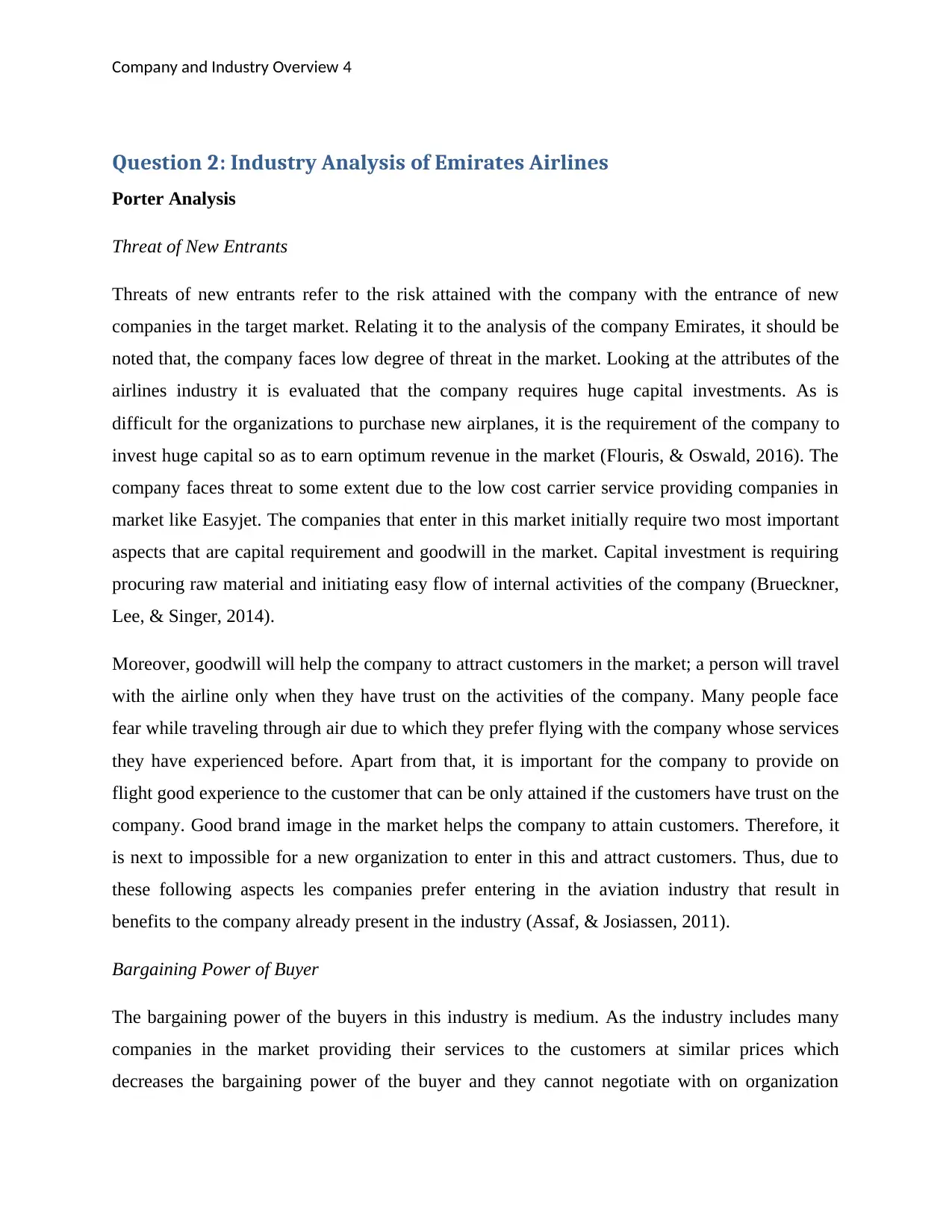
Company and Industry Overview 4
Question 2: Industry Analysis of Emirates Airlines
Porter Analysis
Threat of New Entrants
Threats of new entrants refer to the risk attained with the company with the entrance of new
companies in the target market. Relating it to the analysis of the company Emirates, it should be
noted that, the company faces low degree of threat in the market. Looking at the attributes of the
airlines industry it is evaluated that the company requires huge capital investments. As is
difficult for the organizations to purchase new airplanes, it is the requirement of the company to
invest huge capital so as to earn optimum revenue in the market (Flouris, & Oswald, 2016). The
company faces threat to some extent due to the low cost carrier service providing companies in
market like Easyjet. The companies that enter in this market initially require two most important
aspects that are capital requirement and goodwill in the market. Capital investment is requiring
procuring raw material and initiating easy flow of internal activities of the company (Brueckner,
Lee, & Singer, 2014).
Moreover, goodwill will help the company to attract customers in the market; a person will travel
with the airline only when they have trust on the activities of the company. Many people face
fear while traveling through air due to which they prefer flying with the company whose services
they have experienced before. Apart from that, it is important for the company to provide on
flight good experience to the customer that can be only attained if the customers have trust on the
company. Good brand image in the market helps the company to attain customers. Therefore, it
is next to impossible for a new organization to enter in this and attract customers. Thus, due to
these following aspects les companies prefer entering in the aviation industry that result in
benefits to the company already present in the industry (Assaf, & Josiassen, 2011).
Bargaining Power of Buyer
The bargaining power of the buyers in this industry is medium. As the industry includes many
companies in the market providing their services to the customers at similar prices which
decreases the bargaining power of the buyer and they cannot negotiate with on organization
Question 2: Industry Analysis of Emirates Airlines
Porter Analysis
Threat of New Entrants
Threats of new entrants refer to the risk attained with the company with the entrance of new
companies in the target market. Relating it to the analysis of the company Emirates, it should be
noted that, the company faces low degree of threat in the market. Looking at the attributes of the
airlines industry it is evaluated that the company requires huge capital investments. As is
difficult for the organizations to purchase new airplanes, it is the requirement of the company to
invest huge capital so as to earn optimum revenue in the market (Flouris, & Oswald, 2016). The
company faces threat to some extent due to the low cost carrier service providing companies in
market like Easyjet. The companies that enter in this market initially require two most important
aspects that are capital requirement and goodwill in the market. Capital investment is requiring
procuring raw material and initiating easy flow of internal activities of the company (Brueckner,
Lee, & Singer, 2014).
Moreover, goodwill will help the company to attract customers in the market; a person will travel
with the airline only when they have trust on the activities of the company. Many people face
fear while traveling through air due to which they prefer flying with the company whose services
they have experienced before. Apart from that, it is important for the company to provide on
flight good experience to the customer that can be only attained if the customers have trust on the
company. Good brand image in the market helps the company to attain customers. Therefore, it
is next to impossible for a new organization to enter in this and attract customers. Thus, due to
these following aspects les companies prefer entering in the aviation industry that result in
benefits to the company already present in the industry (Assaf, & Josiassen, 2011).
Bargaining Power of Buyer
The bargaining power of the buyers in this industry is medium. As the industry includes many
companies in the market providing their services to the customers at similar prices which
decreases the bargaining power of the buyer and they cannot negotiate with on organization
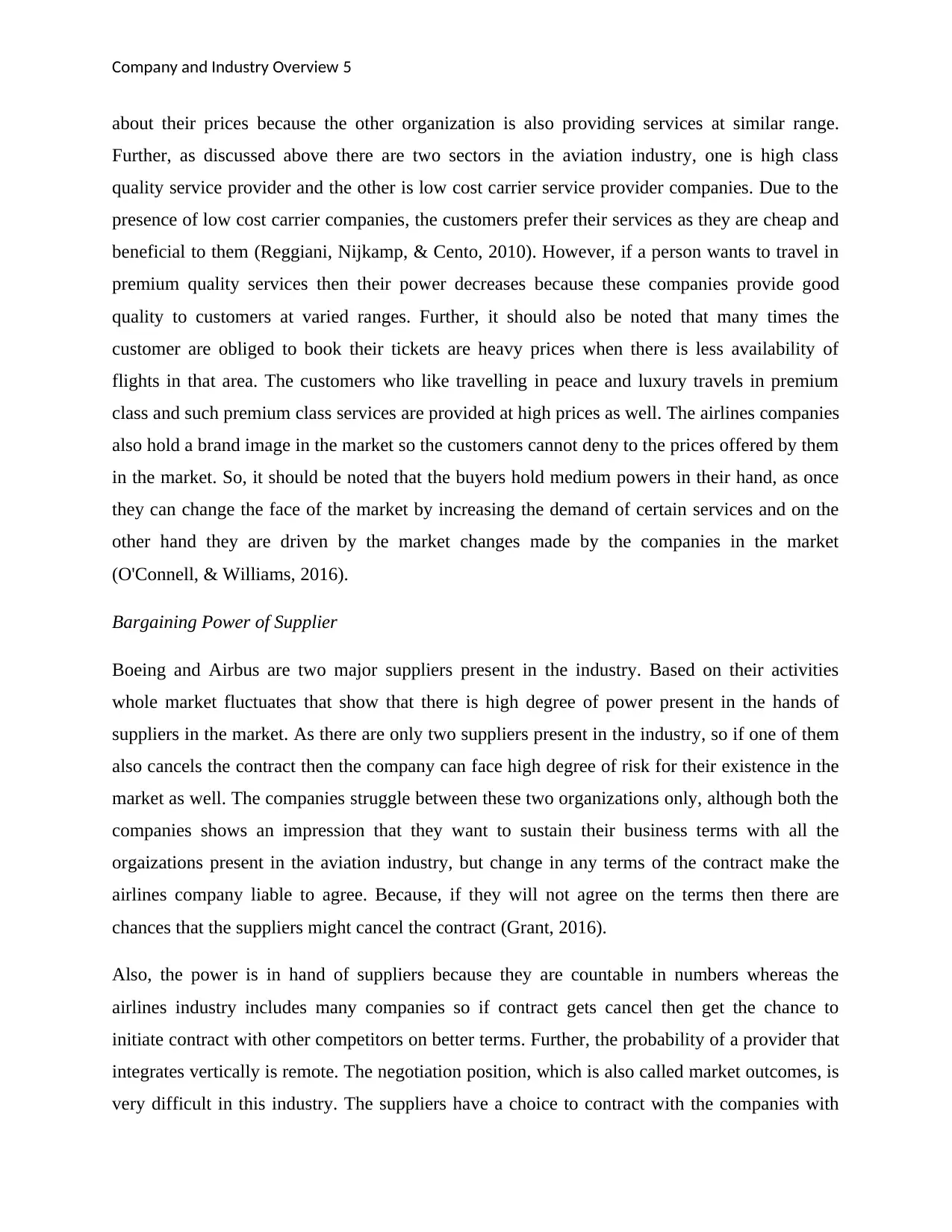
Company and Industry Overview 5
about their prices because the other organization is also providing services at similar range.
Further, as discussed above there are two sectors in the aviation industry, one is high class
quality service provider and the other is low cost carrier service provider companies. Due to the
presence of low cost carrier companies, the customers prefer their services as they are cheap and
beneficial to them (Reggiani, Nijkamp, & Cento, 2010). However, if a person wants to travel in
premium quality services then their power decreases because these companies provide good
quality to customers at varied ranges. Further, it should also be noted that many times the
customer are obliged to book their tickets are heavy prices when there is less availability of
flights in that area. The customers who like travelling in peace and luxury travels in premium
class and such premium class services are provided at high prices as well. The airlines companies
also hold a brand image in the market so the customers cannot deny to the prices offered by them
in the market. So, it should be noted that the buyers hold medium powers in their hand, as once
they can change the face of the market by increasing the demand of certain services and on the
other hand they are driven by the market changes made by the companies in the market
(O'Connell, & Williams, 2016).
Bargaining Power of Supplier
Boeing and Airbus are two major suppliers present in the industry. Based on their activities
whole market fluctuates that show that there is high degree of power present in the hands of
suppliers in the market. As there are only two suppliers present in the industry, so if one of them
also cancels the contract then the company can face high degree of risk for their existence in the
market as well. The companies struggle between these two organizations only, although both the
companies shows an impression that they want to sustain their business terms with all the
orgaizations present in the aviation industry, but change in any terms of the contract make the
airlines company liable to agree. Because, if they will not agree on the terms then there are
chances that the suppliers might cancel the contract (Grant, 2016).
Also, the power is in hand of suppliers because they are countable in numbers whereas the
airlines industry includes many companies so if contract gets cancel then get the chance to
initiate contract with other competitors on better terms. Further, the probability of a provider that
integrates vertically is remote. The negotiation position, which is also called market outcomes, is
very difficult in this industry. The suppliers have a choice to contract with the companies with
about their prices because the other organization is also providing services at similar range.
Further, as discussed above there are two sectors in the aviation industry, one is high class
quality service provider and the other is low cost carrier service provider companies. Due to the
presence of low cost carrier companies, the customers prefer their services as they are cheap and
beneficial to them (Reggiani, Nijkamp, & Cento, 2010). However, if a person wants to travel in
premium quality services then their power decreases because these companies provide good
quality to customers at varied ranges. Further, it should also be noted that many times the
customer are obliged to book their tickets are heavy prices when there is less availability of
flights in that area. The customers who like travelling in peace and luxury travels in premium
class and such premium class services are provided at high prices as well. The airlines companies
also hold a brand image in the market so the customers cannot deny to the prices offered by them
in the market. So, it should be noted that the buyers hold medium powers in their hand, as once
they can change the face of the market by increasing the demand of certain services and on the
other hand they are driven by the market changes made by the companies in the market
(O'Connell, & Williams, 2016).
Bargaining Power of Supplier
Boeing and Airbus are two major suppliers present in the industry. Based on their activities
whole market fluctuates that show that there is high degree of power present in the hands of
suppliers in the market. As there are only two suppliers present in the industry, so if one of them
also cancels the contract then the company can face high degree of risk for their existence in the
market as well. The companies struggle between these two organizations only, although both the
companies shows an impression that they want to sustain their business terms with all the
orgaizations present in the aviation industry, but change in any terms of the contract make the
airlines company liable to agree. Because, if they will not agree on the terms then there are
chances that the suppliers might cancel the contract (Grant, 2016).
Also, the power is in hand of suppliers because they are countable in numbers whereas the
airlines industry includes many companies so if contract gets cancel then get the chance to
initiate contract with other competitors on better terms. Further, the probability of a provider that
integrates vertically is remote. The negotiation position, which is also called market outcomes, is
very difficult in this industry. The suppliers have a choice to contract with the companies with
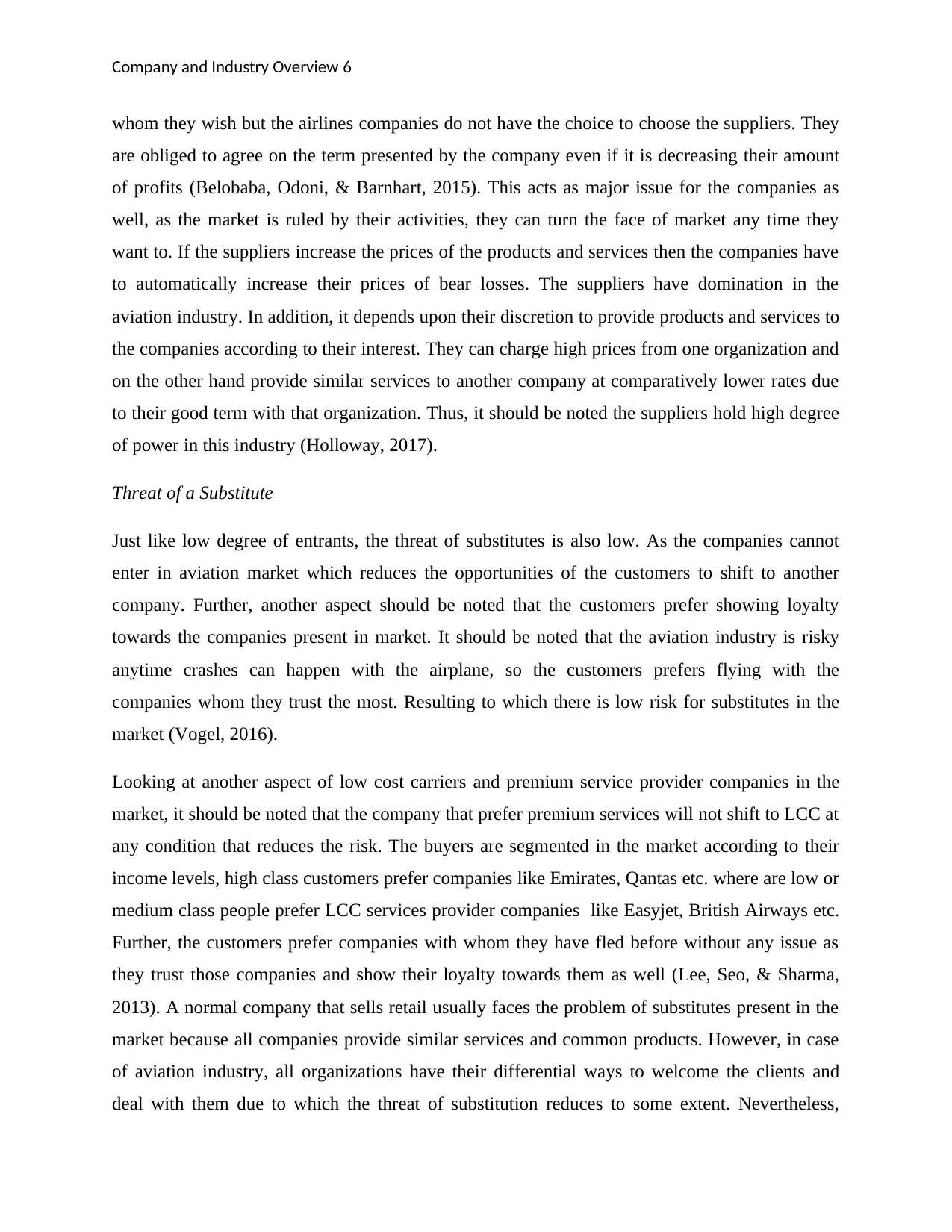
Company and Industry Overview 6
whom they wish but the airlines companies do not have the choice to choose the suppliers. They
are obliged to agree on the term presented by the company even if it is decreasing their amount
of profits (Belobaba, Odoni, & Barnhart, 2015). This acts as major issue for the companies as
well, as the market is ruled by their activities, they can turn the face of market any time they
want to. If the suppliers increase the prices of the products and services then the companies have
to automatically increase their prices of bear losses. The suppliers have domination in the
aviation industry. In addition, it depends upon their discretion to provide products and services to
the companies according to their interest. They can charge high prices from one organization and
on the other hand provide similar services to another company at comparatively lower rates due
to their good term with that organization. Thus, it should be noted the suppliers hold high degree
of power in this industry (Holloway, 2017).
Threat of a Substitute
Just like low degree of entrants, the threat of substitutes is also low. As the companies cannot
enter in aviation market which reduces the opportunities of the customers to shift to another
company. Further, another aspect should be noted that the customers prefer showing loyalty
towards the companies present in market. It should be noted that the aviation industry is risky
anytime crashes can happen with the airplane, so the customers prefers flying with the
companies whom they trust the most. Resulting to which there is low risk for substitutes in the
market (Vogel, 2016).
Looking at another aspect of low cost carriers and premium service provider companies in the
market, it should be noted that the company that prefer premium services will not shift to LCC at
any condition that reduces the risk. The buyers are segmented in the market according to their
income levels, high class customers prefer companies like Emirates, Qantas etc. where are low or
medium class people prefer LCC services provider companies like Easyjet, British Airways etc.
Further, the customers prefer companies with whom they have fled before without any issue as
they trust those companies and show their loyalty towards them as well (Lee, Seo, & Sharma,
2013). A normal company that sells retail usually faces the problem of substitutes present in the
market because all companies provide similar services and common products. However, in case
of aviation industry, all organizations have their differential ways to welcome the clients and
deal with them due to which the threat of substitution reduces to some extent. Nevertheless,
whom they wish but the airlines companies do not have the choice to choose the suppliers. They
are obliged to agree on the term presented by the company even if it is decreasing their amount
of profits (Belobaba, Odoni, & Barnhart, 2015). This acts as major issue for the companies as
well, as the market is ruled by their activities, they can turn the face of market any time they
want to. If the suppliers increase the prices of the products and services then the companies have
to automatically increase their prices of bear losses. The suppliers have domination in the
aviation industry. In addition, it depends upon their discretion to provide products and services to
the companies according to their interest. They can charge high prices from one organization and
on the other hand provide similar services to another company at comparatively lower rates due
to their good term with that organization. Thus, it should be noted the suppliers hold high degree
of power in this industry (Holloway, 2017).
Threat of a Substitute
Just like low degree of entrants, the threat of substitutes is also low. As the companies cannot
enter in aviation market which reduces the opportunities of the customers to shift to another
company. Further, another aspect should be noted that the customers prefer showing loyalty
towards the companies present in market. It should be noted that the aviation industry is risky
anytime crashes can happen with the airplane, so the customers prefers flying with the
companies whom they trust the most. Resulting to which there is low risk for substitutes in the
market (Vogel, 2016).
Looking at another aspect of low cost carriers and premium service provider companies in the
market, it should be noted that the company that prefer premium services will not shift to LCC at
any condition that reduces the risk. The buyers are segmented in the market according to their
income levels, high class customers prefer companies like Emirates, Qantas etc. where are low or
medium class people prefer LCC services provider companies like Easyjet, British Airways etc.
Further, the customers prefer companies with whom they have fled before without any issue as
they trust those companies and show their loyalty towards them as well (Lee, Seo, & Sharma,
2013). A normal company that sells retail usually faces the problem of substitutes present in the
market because all companies provide similar services and common products. However, in case
of aviation industry, all organizations have their differential ways to welcome the clients and
deal with them due to which the threat of substitution reduces to some extent. Nevertheless,
Paraphrase This Document
Need a fresh take? Get an instant paraphrase of this document with our AI Paraphraser
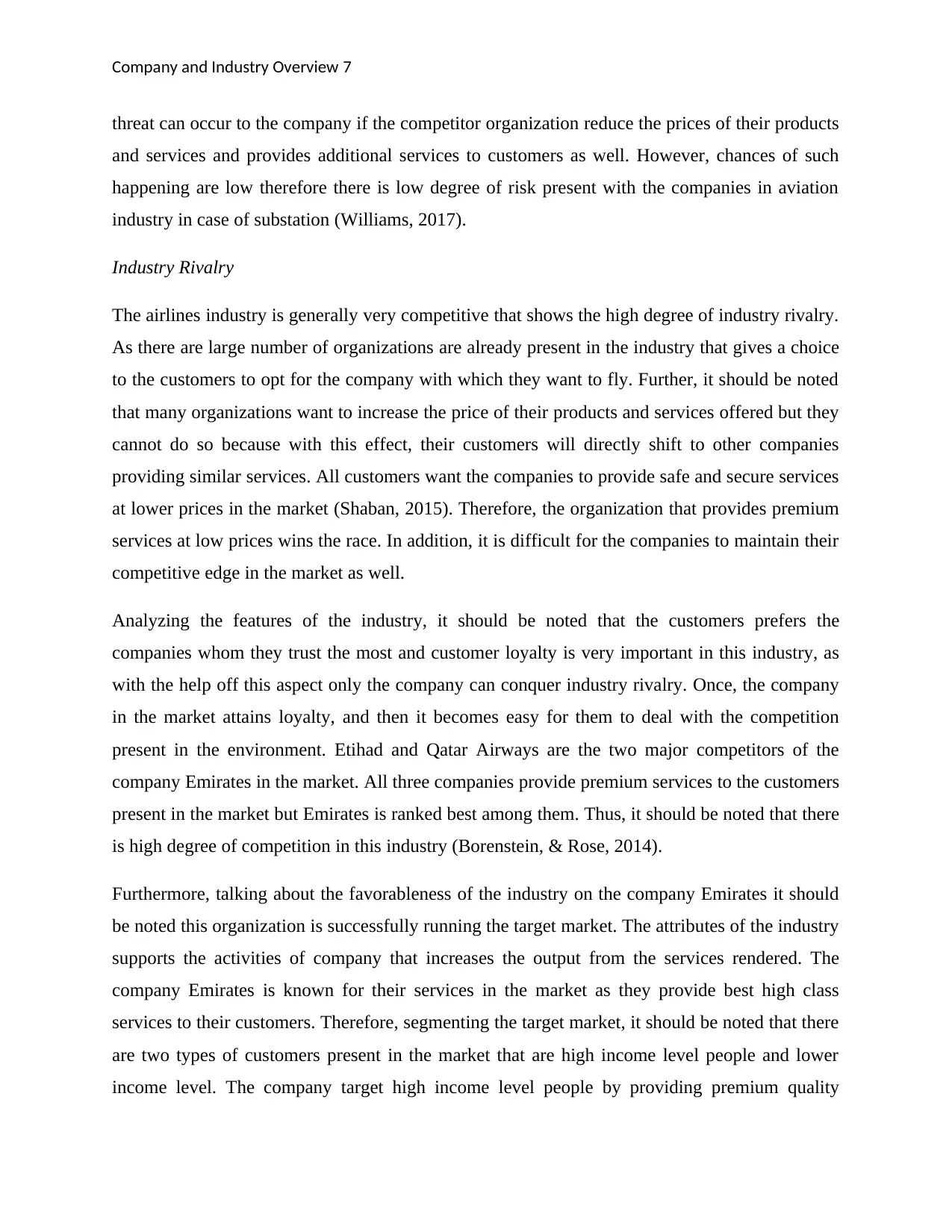
Company and Industry Overview 7
threat can occur to the company if the competitor organization reduce the prices of their products
and services and provides additional services to customers as well. However, chances of such
happening are low therefore there is low degree of risk present with the companies in aviation
industry in case of substation (Williams, 2017).
Industry Rivalry
The airlines industry is generally very competitive that shows the high degree of industry rivalry.
As there are large number of organizations are already present in the industry that gives a choice
to the customers to opt for the company with which they want to fly. Further, it should be noted
that many organizations want to increase the price of their products and services offered but they
cannot do so because with this effect, their customers will directly shift to other companies
providing similar services. All customers want the companies to provide safe and secure services
at lower prices in the market (Shaban, 2015). Therefore, the organization that provides premium
services at low prices wins the race. In addition, it is difficult for the companies to maintain their
competitive edge in the market as well.
Analyzing the features of the industry, it should be noted that the customers prefers the
companies whom they trust the most and customer loyalty is very important in this industry, as
with the help off this aspect only the company can conquer industry rivalry. Once, the company
in the market attains loyalty, and then it becomes easy for them to deal with the competition
present in the environment. Etihad and Qatar Airways are the two major competitors of the
company Emirates in the market. All three companies provide premium services to the customers
present in the market but Emirates is ranked best among them. Thus, it should be noted that there
is high degree of competition in this industry (Borenstein, & Rose, 2014).
Furthermore, talking about the favorableness of the industry on the company Emirates it should
be noted this organization is successfully running the target market. The attributes of the industry
supports the activities of company that increases the output from the services rendered. The
company Emirates is known for their services in the market as they provide best high class
services to their customers. Therefore, segmenting the target market, it should be noted that there
are two types of customers present in the market that are high income level people and lower
income level. The company target high income level people by providing premium quality
threat can occur to the company if the competitor organization reduce the prices of their products
and services and provides additional services to customers as well. However, chances of such
happening are low therefore there is low degree of risk present with the companies in aviation
industry in case of substation (Williams, 2017).
Industry Rivalry
The airlines industry is generally very competitive that shows the high degree of industry rivalry.
As there are large number of organizations are already present in the industry that gives a choice
to the customers to opt for the company with which they want to fly. Further, it should be noted
that many organizations want to increase the price of their products and services offered but they
cannot do so because with this effect, their customers will directly shift to other companies
providing similar services. All customers want the companies to provide safe and secure services
at lower prices in the market (Shaban, 2015). Therefore, the organization that provides premium
services at low prices wins the race. In addition, it is difficult for the companies to maintain their
competitive edge in the market as well.
Analyzing the features of the industry, it should be noted that the customers prefers the
companies whom they trust the most and customer loyalty is very important in this industry, as
with the help off this aspect only the company can conquer industry rivalry. Once, the company
in the market attains loyalty, and then it becomes easy for them to deal with the competition
present in the environment. Etihad and Qatar Airways are the two major competitors of the
company Emirates in the market. All three companies provide premium services to the customers
present in the market but Emirates is ranked best among them. Thus, it should be noted that there
is high degree of competition in this industry (Borenstein, & Rose, 2014).
Furthermore, talking about the favorableness of the industry on the company Emirates it should
be noted this organization is successfully running the target market. The attributes of the industry
supports the activities of company that increases the output from the services rendered. The
company Emirates is known for their services in the market as they provide best high class
services to their customers. Therefore, segmenting the target market, it should be noted that there
are two types of customers present in the market that are high income level people and lower
income level. The company target high income level people by providing premium quality
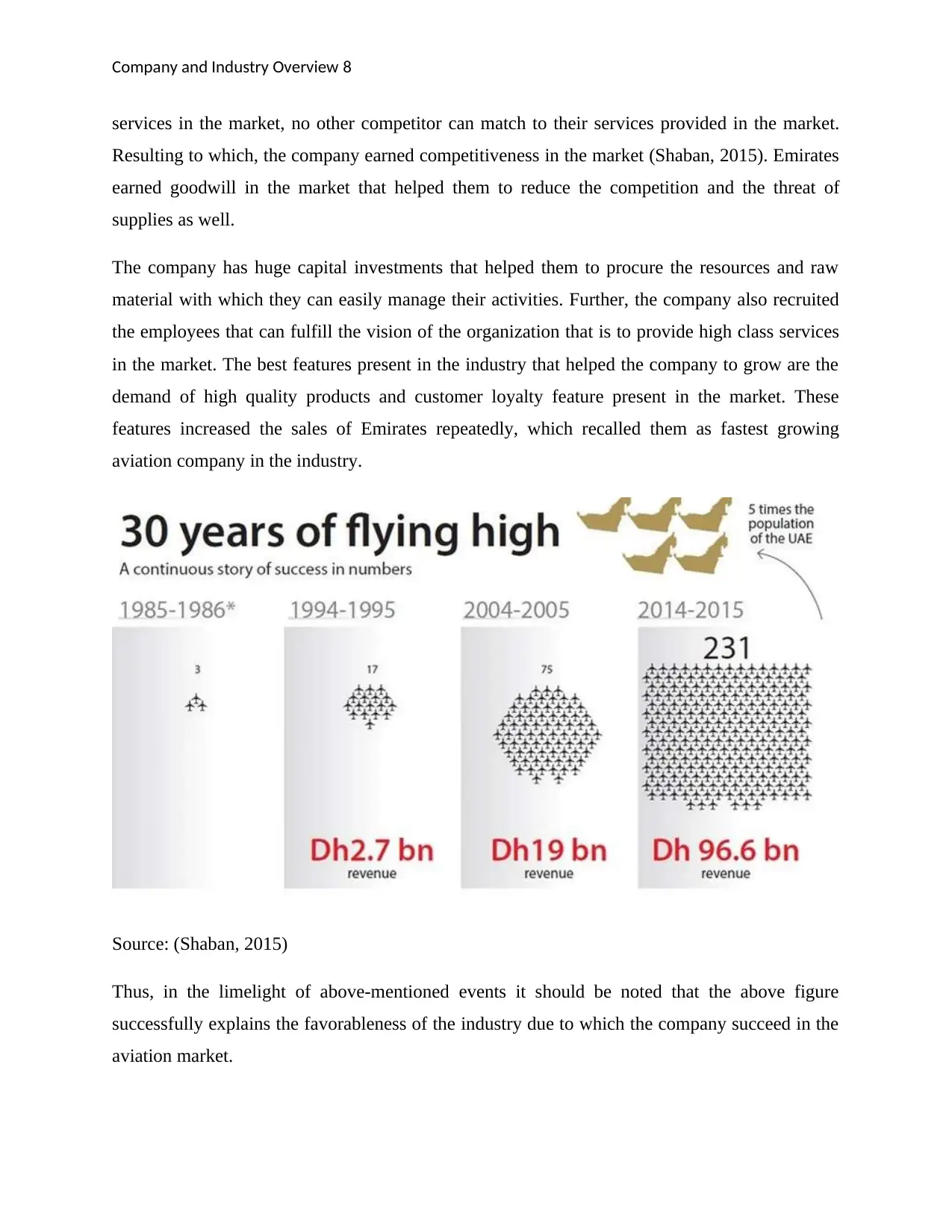
Company and Industry Overview 8
services in the market, no other competitor can match to their services provided in the market.
Resulting to which, the company earned competitiveness in the market (Shaban, 2015). Emirates
earned goodwill in the market that helped them to reduce the competition and the threat of
supplies as well.
The company has huge capital investments that helped them to procure the resources and raw
material with which they can easily manage their activities. Further, the company also recruited
the employees that can fulfill the vision of the organization that is to provide high class services
in the market. The best features present in the industry that helped the company to grow are the
demand of high quality products and customer loyalty feature present in the market. These
features increased the sales of Emirates repeatedly, which recalled them as fastest growing
aviation company in the industry.
Source: (Shaban, 2015)
Thus, in the limelight of above-mentioned events it should be noted that the above figure
successfully explains the favorableness of the industry due to which the company succeed in the
aviation market.
services in the market, no other competitor can match to their services provided in the market.
Resulting to which, the company earned competitiveness in the market (Shaban, 2015). Emirates
earned goodwill in the market that helped them to reduce the competition and the threat of
supplies as well.
The company has huge capital investments that helped them to procure the resources and raw
material with which they can easily manage their activities. Further, the company also recruited
the employees that can fulfill the vision of the organization that is to provide high class services
in the market. The best features present in the industry that helped the company to grow are the
demand of high quality products and customer loyalty feature present in the market. These
features increased the sales of Emirates repeatedly, which recalled them as fastest growing
aviation company in the industry.
Source: (Shaban, 2015)
Thus, in the limelight of above-mentioned events it should be noted that the above figure
successfully explains the favorableness of the industry due to which the company succeed in the
aviation market.
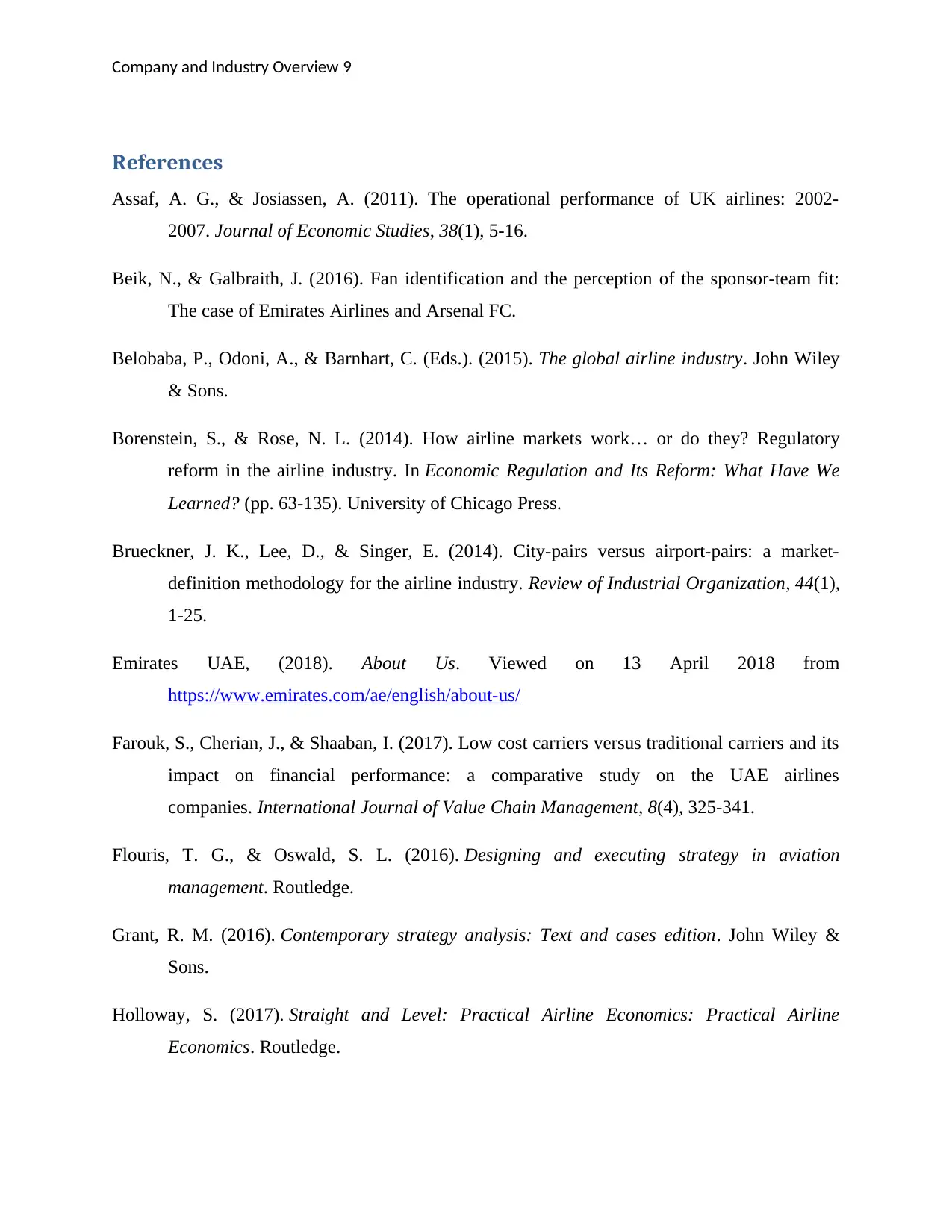
Company and Industry Overview 9
References
Assaf, A. G., & Josiassen, A. (2011). The operational performance of UK airlines: 2002-
2007. Journal of Economic Studies, 38(1), 5-16.
Beik, N., & Galbraith, J. (2016). Fan identification and the perception of the sponsor-team fit:
The case of Emirates Airlines and Arsenal FC.
Belobaba, P., Odoni, A., & Barnhart, C. (Eds.). (2015). The global airline industry. John Wiley
& Sons.
Borenstein, S., & Rose, N. L. (2014). How airline markets work… or do they? Regulatory
reform in the airline industry. In Economic Regulation and Its Reform: What Have We
Learned? (pp. 63-135). University of Chicago Press.
Brueckner, J. K., Lee, D., & Singer, E. (2014). City-pairs versus airport-pairs: a market-
definition methodology for the airline industry. Review of Industrial Organization, 44(1),
1-25.
Emirates UAE, (2018). About Us. Viewed on 13 April 2018 from
https://www.emirates.com/ae/english/about-us/
Farouk, S., Cherian, J., & Shaaban, I. (2017). Low cost carriers versus traditional carriers and its
impact on financial performance: a comparative study on the UAE airlines
companies. International Journal of Value Chain Management, 8(4), 325-341.
Flouris, T. G., & Oswald, S. L. (2016). Designing and executing strategy in aviation
management. Routledge.
Grant, R. M. (2016). Contemporary strategy analysis: Text and cases edition. John Wiley &
Sons.
Holloway, S. (2017). Straight and Level: Practical Airline Economics: Practical Airline
Economics. Routledge.
References
Assaf, A. G., & Josiassen, A. (2011). The operational performance of UK airlines: 2002-
2007. Journal of Economic Studies, 38(1), 5-16.
Beik, N., & Galbraith, J. (2016). Fan identification and the perception of the sponsor-team fit:
The case of Emirates Airlines and Arsenal FC.
Belobaba, P., Odoni, A., & Barnhart, C. (Eds.). (2015). The global airline industry. John Wiley
& Sons.
Borenstein, S., & Rose, N. L. (2014). How airline markets work… or do they? Regulatory
reform in the airline industry. In Economic Regulation and Its Reform: What Have We
Learned? (pp. 63-135). University of Chicago Press.
Brueckner, J. K., Lee, D., & Singer, E. (2014). City-pairs versus airport-pairs: a market-
definition methodology for the airline industry. Review of Industrial Organization, 44(1),
1-25.
Emirates UAE, (2018). About Us. Viewed on 13 April 2018 from
https://www.emirates.com/ae/english/about-us/
Farouk, S., Cherian, J., & Shaaban, I. (2017). Low cost carriers versus traditional carriers and its
impact on financial performance: a comparative study on the UAE airlines
companies. International Journal of Value Chain Management, 8(4), 325-341.
Flouris, T. G., & Oswald, S. L. (2016). Designing and executing strategy in aviation
management. Routledge.
Grant, R. M. (2016). Contemporary strategy analysis: Text and cases edition. John Wiley &
Sons.
Holloway, S. (2017). Straight and Level: Practical Airline Economics: Practical Airline
Economics. Routledge.
Secure Best Marks with AI Grader
Need help grading? Try our AI Grader for instant feedback on your assignments.
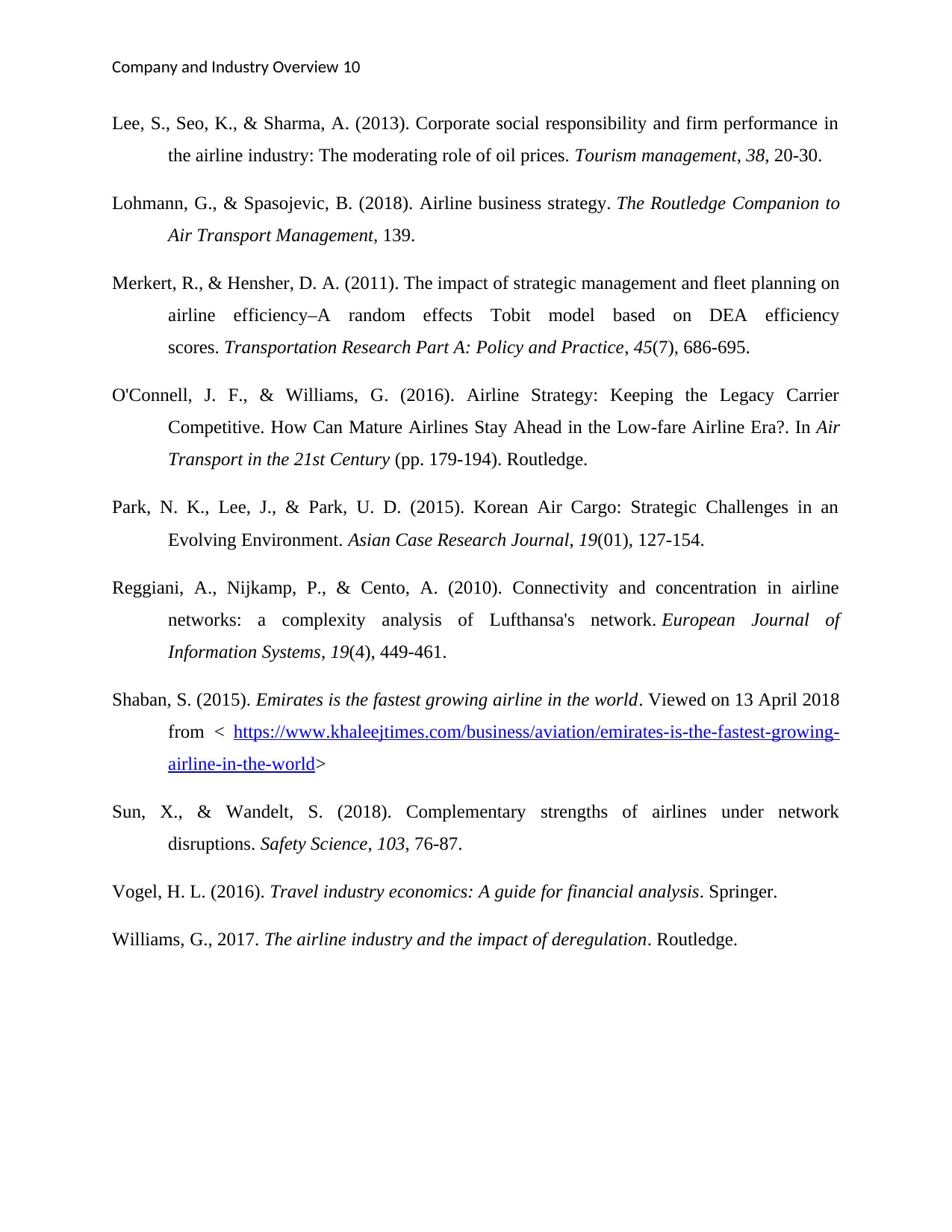
Company and Industry Overview 10
Lee, S., Seo, K., & Sharma, A. (2013). Corporate social responsibility and firm performance in
the airline industry: The moderating role of oil prices. Tourism management, 38, 20-30.
Lohmann, G., & Spasojevic, B. (2018). Airline business strategy. The Routledge Companion to
Air Transport Management, 139.
Merkert, R., & Hensher, D. A. (2011). The impact of strategic management and fleet planning on
airline efficiency–A random effects Tobit model based on DEA efficiency
scores. Transportation Research Part A: Policy and Practice, 45(7), 686-695.
O'Connell, J. F., & Williams, G. (2016). Airline Strategy: Keeping the Legacy Carrier
Competitive. How Can Mature Airlines Stay Ahead in the Low-fare Airline Era?. In Air
Transport in the 21st Century (pp. 179-194). Routledge.
Park, N. K., Lee, J., & Park, U. D. (2015). Korean Air Cargo: Strategic Challenges in an
Evolving Environment. Asian Case Research Journal, 19(01), 127-154.
Reggiani, A., Nijkamp, P., & Cento, A. (2010). Connectivity and concentration in airline
networks: a complexity analysis of Lufthansa's network. European Journal of
Information Systems, 19(4), 449-461.
Shaban, S. (2015). Emirates is the fastest growing airline in the world. Viewed on 13 April 2018
from < https://www.khaleejtimes.com/business/aviation/emirates-is-the-fastest-growing-
airline-in-the-world>
Sun, X., & Wandelt, S. (2018). Complementary strengths of airlines under network
disruptions. Safety Science, 103, 76-87.
Vogel, H. L. (2016). Travel industry economics: A guide for financial analysis. Springer.
Williams, G., 2017. The airline industry and the impact of deregulation. Routledge.
Lee, S., Seo, K., & Sharma, A. (2013). Corporate social responsibility and firm performance in
the airline industry: The moderating role of oil prices. Tourism management, 38, 20-30.
Lohmann, G., & Spasojevic, B. (2018). Airline business strategy. The Routledge Companion to
Air Transport Management, 139.
Merkert, R., & Hensher, D. A. (2011). The impact of strategic management and fleet planning on
airline efficiency–A random effects Tobit model based on DEA efficiency
scores. Transportation Research Part A: Policy and Practice, 45(7), 686-695.
O'Connell, J. F., & Williams, G. (2016). Airline Strategy: Keeping the Legacy Carrier
Competitive. How Can Mature Airlines Stay Ahead in the Low-fare Airline Era?. In Air
Transport in the 21st Century (pp. 179-194). Routledge.
Park, N. K., Lee, J., & Park, U. D. (2015). Korean Air Cargo: Strategic Challenges in an
Evolving Environment. Asian Case Research Journal, 19(01), 127-154.
Reggiani, A., Nijkamp, P., & Cento, A. (2010). Connectivity and concentration in airline
networks: a complexity analysis of Lufthansa's network. European Journal of
Information Systems, 19(4), 449-461.
Shaban, S. (2015). Emirates is the fastest growing airline in the world. Viewed on 13 April 2018
from < https://www.khaleejtimes.com/business/aviation/emirates-is-the-fastest-growing-
airline-in-the-world>
Sun, X., & Wandelt, S. (2018). Complementary strengths of airlines under network
disruptions. Safety Science, 103, 76-87.
Vogel, H. L. (2016). Travel industry economics: A guide for financial analysis. Springer.
Williams, G., 2017. The airline industry and the impact of deregulation. Routledge.
1 out of 11
Related Documents
Your All-in-One AI-Powered Toolkit for Academic Success.
+13062052269
info@desklib.com
Available 24*7 on WhatsApp / Email
![[object Object]](/_next/static/media/star-bottom.7253800d.svg)
Unlock your academic potential
© 2024 | Zucol Services PVT LTD | All rights reserved.





